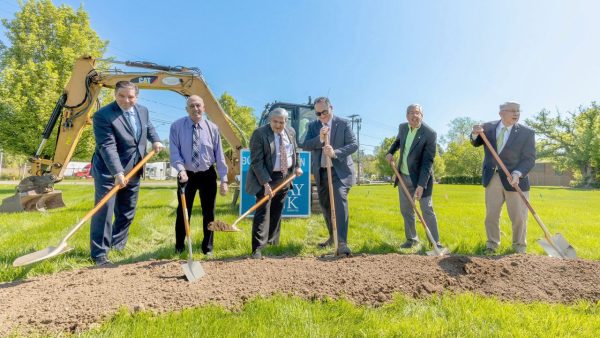Get our email updates
Stay up-to-date on the companies, people and issues that impact businesses in Syracuse, Central New York and beyond.
What's New
Upcoming Events
CNYBJ Job Board

Solvay Bank names branch manager for upcoming East Syracuse–area branch
DeWITT, N.Y. — Briana Fox will serve as AVP, branch manager for Solvay Bank’s upcoming East Syracuse–area location at the Wegmans plaza on James Street in the town of DeWitt. It will be the 10th branch for Solvay Bank, the oldest community bank established in Onondaga County, per the Nov. 6 announcement. Fox joined Solvay […]
Get Instant Access to This Article
Become a Central New York Business Journal subscriber and get immediate access to all of our subscriber-only content and much more.
- Critical Central New York business news and analysis updated daily.
- Immediate access to all subscriber-only content on our website.
- Get a year’s worth of the Print Edition of The Central New York Business Journal.
- Special Feature Publications such as the Book of Lists and Revitalize Greater Binghamton, Mohawk Valley, and Syracuse Magazines
Click here to purchase a paywall bypass link for this article.
DeWITT, N.Y. — Briana Fox will serve as AVP, branch manager for Solvay Bank’s upcoming East Syracuse–area location at the Wegmans plaza on James Street in the town of DeWitt.

It will be the 10th branch for Solvay Bank, the oldest community bank established in Onondaga County, per the Nov. 6 announcement.
Fox joined Solvay Bank in 2016 as a banking solutions representative at its Fairmount office. Along the way, Solvay Bank promoted Fox to assistant branch manager at Solvay Bank’s DeWitt location, and most recently, branch manager for the North Syracuse office.
The future 2,200-square-foot Smart Office, located in the Wegmans plaza on James Street, is making “significant” progress, with framing now complete and further phases “actively underway” Solvay Bank noted. This branch will offer personal, business, and municipal-banking products and services.
Founded in 1917, Solvay Bank currently has nine branch locations in Solvay, Baldwinsville, Camillus, Cicero, DeWitt, Liverpool, North Syracuse, Westvale, and downtown Syracuse in the State Tower Building, as well as a commercial lending presence in the Mohawk Valley.

Sheriff’s union has new tentative labor contract with Onondaga County
SYRACUSE, N.Y. — The Onondaga County Deputy Sheriff’s Police Association (OCSPA) has a tentative new labor contract with the Onondaga County government. The Onondaga County Legislature will vote to finalize the deal in December, according to the county’s Nov. 19 announcement. The four-year pact includes a wage increase of 3 percent per year as well
Get Instant Access to This Article
Become a Central New York Business Journal subscriber and get immediate access to all of our subscriber-only content and much more.
- Critical Central New York business news and analysis updated daily.
- Immediate access to all subscriber-only content on our website.
- Get a year’s worth of the Print Edition of The Central New York Business Journal.
- Special Feature Publications such as the Book of Lists and Revitalize Greater Binghamton, Mohawk Valley, and Syracuse Magazines
Click here to purchase a paywall bypass link for this article.
SYRACUSE, N.Y. — The Onondaga County Deputy Sheriff’s Police Association (OCSPA) has a tentative new labor contract with the Onondaga County government.
The Onondaga County Legislature will vote to finalize the deal in December, according to the county’s Nov. 19 announcement.
The four-year pact includes a wage increase of 3 percent per year as well as an adjusted salary structure for 2026, the office of Onondaga County Executive Ryan McMahon said in its announcement.
The labor agreement addresses topics such as workday holiday premiums, longevity premiums, and required on-call occurrences premiums.
OCSPA came to the county executive and his team, hoping to obtain a contract that solved three areas of concern, Bill June, president of the OCSPA union, said.
“We wanted a contract that allowed us to recruit the best potential candidates, we wanted to have a contract that helped us retain Deputies beyond their potential 20-year retirement, and we wanted our Deputies to earn a wage that is fair and equitable compared to the other agencies within Onondaga County,” June said. “Executive McMahon and his team were able to meet all our objectives and then some. The Deputies, Sergeants, and Lieutenants of OCSPA want to thank Executive McMahon and his team for supporting us and giving us the tools and the contract we need to continue to meet our goals and objectives.”
The four-year agreement starts retroactively to Jan. 1, 2025 and continues through Dec. 31, 2028.
Speaking during a media availability on Nov. 19, McMahon called the tentative labor contract a “really big win for us.”
“Our police officers, as we know, across the country were having challenges recruiting into these ranks and certainly we think we’ve come to an agreement that will help (A) recognize the unique sacrifices of these individuals, these men and women, and (B) help us retain [recruits],” McMahon said. “Public safety is really the number one responsibility of this government and this helps us tremendously.”
McMahon congratulated June on a successful negotiation with the county’s team. CNYBJ monitored the McMahon availability on the Onondaga County Executive Office YouTube channel.
Onondaga County Sheriff Toby Shelley called it more than a contract; it is a “recognition of the dedication, professionalism, and sacrifice our deputies demonstrate every single day.”
“The men and women of the Onondaga County Sheriff’s Office are among the most highly trained and premier law enforcement professionals in New York State, and they deserve to be compensated in a way that reflects their commitment to this community,” Shelley said in the county’s announcement. “I am immensely proud of the work they do, and grateful to everyone who helped make this agreement a reality.”

AAA Western and Central New York names new director of insurance
AMHERST, N.Y. — AAA Western and Central New York says it has a new director of insurance. Jen Ketchum brings 21 years of experience in both insurance sales and service to the role, which oversees all insurance operations across AAA’s regional footprint in Western and Central New York. She will manage the entire insurance team
Get Instant Access to This Article
Become a Central New York Business Journal subscriber and get immediate access to all of our subscriber-only content and much more.
- Critical Central New York business news and analysis updated daily.
- Immediate access to all subscriber-only content on our website.
- Get a year’s worth of the Print Edition of The Central New York Business Journal.
- Special Feature Publications such as the Book of Lists and Revitalize Greater Binghamton, Mohawk Valley, and Syracuse Magazines
Click here to purchase a paywall bypass link for this article.
AMHERST, N.Y. — AAA Western and Central New York says it has a new director of insurance.
Jen Ketchum brings 21 years of experience in both insurance sales and service to the role, which oversees all insurance operations across AAA’s regional footprint in Western and Central New York.
She will manage the entire insurance team from AAA’s corporate headquarters in the Buffalo suburb of Amherst.
Throughout her career, Ketchum has specialized in different aspects of personal insurance, along with commercial lines, which will be her focus at AAA.
“AAA Insurance has built an exceptional culture, and my goal is to further strengthen that foundation by driving growth and alignment across our personal and commercial lines.” she said in the Nov. 10 AAA announcement. “I’m passionate about leading and empowering high-performing teams, developing strong leaders, and fostering collaboration across business units. I’m excited to work alongside the outgoing and dynamic team at AAA.”
Ketchum, who holds property and casualty and life and health licenses, has been responsible for hiring and onboarding, promoting growth in insurance, developing carrier relationships, and streamlining processes and procedures in various roles over the past two decades, AAA said.
“I enjoy collaborating with individuals to help them discover their own value and achieve career success, as well as solving problems to identify the most efficient solutions for long-term growth,” she noted.
Ketchum earned a bachelor’s degree in psychology and MBA degree from St. Bonaventure University, as well as her CPCU (short for Chartered Property Casualty Underwriter).

WNY health insurer affiliates with MVP Health Care
SCHENECTADY, N.Y. — A Western New York health plan is affiliating with Schenectady–based MVP Health Care. Independent Health will join MVP’s family of companies, subject to regulatory approvals. The boards of directors of both organizations unanimously approved the transaction, per MVP’s Nov. 18 announcement. Neither health insurer released financial terms of their agreement. In their
Get Instant Access to This Article
Become a Central New York Business Journal subscriber and get immediate access to all of our subscriber-only content and much more.
- Critical Central New York business news and analysis updated daily.
- Immediate access to all subscriber-only content on our website.
- Get a year’s worth of the Print Edition of The Central New York Business Journal.
- Special Feature Publications such as the Book of Lists and Revitalize Greater Binghamton, Mohawk Valley, and Syracuse Magazines
Click here to purchase a paywall bypass link for this article.
SCHENECTADY, N.Y. — A Western New York health plan is affiliating with Schenectady–based MVP Health Care.
Independent Health will join MVP’s family of companies, subject to regulatory approvals. The boards of directors of both organizations unanimously approved the transaction, per MVP’s Nov. 18 announcement. Neither health insurer released financial terms of their agreement.
In their affiliation, MVP and Independent Health will serve nearly 1 million members and employ more than 3,000 people across the region with $7 billion in annual revenue.
“As our family grows, we remain steadfast in our purpose: putting people at the center of their health journey,” Chris Del Vecchio, CEO of MVP Health Care, said in the announcement. “This is not just about aligning organizations; it is about creating a future-focused health care system that empowers individuals to live their healthiest, most vibrant lives. By accelerating innovation, rethinking the care experience, and embracing bold changes, we are taking a critical step forward to meet the growing needs of our members and communities.”
As MVP Health Care explained it, the health-care industry continues to face “significant” challenges, including rising medical and pharmaceutical costs, regulatory pressures, and the “complexities of delivering care in a rapidly changing landscape.” Recognizing these realities, MVP Health Care and Independent Health say they are working proactively to “shape a system that prioritizes individuals over processes.”
“Independent Health has long been recognized for our focus on delivering the highest quality care and service to our members and our community,” Dr. Michael Cropp, president and CEO of Independent Health, contended in the MVP announcement. “Joining the MVP Health Care family allows us to innovate further while staying true to the communities we serve. By aligning our strengths and shared values, we are not only preparing for today’s challenges — but we are designing health care for the future, where every person feels empowered and supported to achieve their best health.”
About the health plans
Besides its Schenectady headquarters, MVP Health Care also operates an office in Rochester. It previously operated an office in Syracuse.
MVP Health Care serves customers in Central New York counties that include Broome, Cayuga, Chenango, Cortland, Herkimer, Jefferson, Lewis, Madison, Oneida, Onondaga, Oswego, Seneca, Tioga, and Tompkins, per the 2025 Book of Lists.
Established in 1980, Buffalo–based Independent Health offers HMO, POS, PPO and EPO products, Medicare Advantage and Medicaid plans, individual Exchange products, consumer-directed plans, health savings accounts, and coverage for self-funded employers.
Its subsidiaries and affiliate companies include a third-party administrator of health benefits, pharmacy-benefit management, specialty pharmacy, and the Independent Health Foundation.
In all, Independent Health and its affiliates serve a total of more than 550,000 customers across the country.

Five Star Bank parent company to pay Q4 dividend of 31 cents in early January
WARSAW, N.Y. — Financial Institutions, Inc. (NASDAQ: FISI), parent company of Five Star Bank, announced that its board of directors has recently approved a quarterly cash dividend of 31 cents per share of its common stock outstanding. Financial Institutions will pay the fourth-quarter dividend on Jan. 2, to shareholders of record on Dec. 15. At
Get Instant Access to This Article
Become a Central New York Business Journal subscriber and get immediate access to all of our subscriber-only content and much more.
- Critical Central New York business news and analysis updated daily.
- Immediate access to all subscriber-only content on our website.
- Get a year’s worth of the Print Edition of The Central New York Business Journal.
- Special Feature Publications such as the Book of Lists and Revitalize Greater Binghamton, Mohawk Valley, and Syracuse Magazines
Click here to purchase a paywall bypass link for this article.
WARSAW, N.Y. — Financial Institutions, Inc. (NASDAQ: FISI), parent company of Five Star Bank, announced that its board of directors has recently approved a quarterly cash dividend of 31 cents per share of its common stock outstanding.
Financial Institutions will pay the fourth-quarter dividend on Jan. 2, to shareholders of record on Dec. 15.
At the banking company’s current stock price, the dividend yields about 4.2 percent on an annual basis.
Financial Institutions is a financial holding company, based in Warsaw in New York’s Wyoming County, with about $6.3 billion in assets, offering banking and wealth-management products and services. Its Five Star Bank subsidiary provides consumer and commercial banking and lending services to individuals, municipalities, and businesses through banking locations spanning Western and Central New York and a commercial-loan production office serving the Mid-Atlantic region. Five Star Bank’s Central New York offices include a commercial-loan production office in Syracuse and retail branches in Auburn, Waterloo, and Geneva.

DEC announces land acquisition to preserve more than 3,300 acres in Herkimer County
SALISBURY, N.Y. — The New York State Department of Environmental Conservation (DEC) on Oct. 22 announced the acquisition of 3,387 acres of forest and wetlands located in the towns of Salisbury and Norway in Herkimer County. The parcel, purchased from the Open Space Institute (OSI), will be managed for forest products, expanded recreational access, protection
Get Instant Access to This Article
Become a Central New York Business Journal subscriber and get immediate access to all of our subscriber-only content and much more.
- Critical Central New York business news and analysis updated daily.
- Immediate access to all subscriber-only content on our website.
- Get a year’s worth of the Print Edition of The Central New York Business Journal.
- Special Feature Publications such as the Book of Lists and Revitalize Greater Binghamton, Mohawk Valley, and Syracuse Magazines
Click here to purchase a paywall bypass link for this article.
SALISBURY, N.Y. — The New York State Department of Environmental Conservation (DEC) on Oct. 22 announced the acquisition of 3,387 acres of forest and wetlands located in the towns of Salisbury and Norway in Herkimer County.
The parcel, purchased from the Open Space Institute (OSI), will be managed for forest products, expanded recreational access, protection of critical drinking water sources, and enhancement of ecosystem resilience, per the announcement.
The property includes hardwood and softwood forests, nearly 900 acres of wetlands, and several miles of Spruce Creek, a tributary of the East Canada Creek which eventually flows into the Mohawk River. The property sits just outside the southwestern boundary of the Adirondack Forest Preserve and connects to more than 150,000 acres of DEC’s Ferris Lake Wild Forest, the DEC said.
The wetlands and forests on the parcel provide habitat for a wide range of species including black bear, white-tailed deer, bobcat, river otter, and fisher. These features also play a vital role in filtering rainwater that serves as part of the drinking water supply for the city of Little Falls, the department stated.
Ten acres of the property will be added to the Adirondack Forest Preserve, while the remaining acreage located just outside of the Adirondack Park boundary will be state forest.
Although the purchase and transfer of the Spruce Creek property are now complete, public access is currently limited to one location off Dairy Hill Road just south of the junction with Guideboard Road. DEC staff are working to establish additional safe and sustainable access points that will support future recreational use while protecting natural resources. The public is asked to respect the limited access during development of these additional points. The DEC said it will provide updates and announce when these improvements are completed.
The acquisition was made possible by OSI’s $3 million land purchase from Datum 9 Forestry LLC. DEC subsequently acquired the 3,387-acre parcel using $3 million from the state’s Environmental Protection Fund (EPF). The EPF supports climate-change mitigation and adaptation efforts, improves agricultural resources to promote sustainable agriculture, protects water sources, advances conservation efforts, and provides recreational opportunities for New Yorkers, the DEC said. The EPF also supports New York’s 30×30 initiative, which commits to conserving 30 percent of lands and waters by 2030.
Oneida County hotel business benchmarks improve in October
UTICA, N.Y. — Oneida County hotels posted an increase in a trio of three key indicators of business performance in October. The hotel-occupancy rate (rooms
Onondaga County hotels see nearly 5 percent increase in occupancy
SYRACUSE, N.Y. — Onondaga County hotels hosted more guests in October, as two other key indicators of business performance also rose during the month. The

Utica First Insurance Company readies for leadership transition
UTICA, N.Y. — Utica First Insurance Company will have a new president and CEO when the calendar turns to 2026. Ryan Fleming will succeed retiring president and CEO Scott Shatraw. The firm announced Fleming’s appointment on Sept. 16. Fleming joined Utica First Insurance in 2024 as VP of marketing and agencies and has “demonstrated his
Get Instant Access to This Article
Become a Central New York Business Journal subscriber and get immediate access to all of our subscriber-only content and much more.
- Critical Central New York business news and analysis updated daily.
- Immediate access to all subscriber-only content on our website.
- Get a year’s worth of the Print Edition of The Central New York Business Journal.
- Special Feature Publications such as the Book of Lists and Revitalize Greater Binghamton, Mohawk Valley, and Syracuse Magazines
Click here to purchase a paywall bypass link for this article.
UTICA, N.Y. — Utica First Insurance Company will have a new president and CEO when the calendar turns to 2026.
Ryan Fleming will succeed retiring president and CEO Scott Shatraw. The firm announced Fleming’s appointment on Sept. 16.
Fleming joined Utica First Insurance in 2024 as VP of marketing and agencies and has “demonstrated his ability to lead the company into the future, advancing its vision and promoting its core values.” Prior to joining Utica First, he worked at The Travelers Indemnity Company.
His responsibilities have included working with the marketing team to increase brand awareness, building strong relationships with key industry partners, retail agents, and wholesalers, and enhancing the agent/broker experience.
He has more than 25 years of insurance industry leadership experience, with a niche in sales and marketing.
“Utica First has an incredibly strong 122-year tradition of putting our agents, brokers, and customers first,” Fleming said in the announcement. “I’m honored and enthusiastic about continuing to build on that legacy with an emphasis on personal service, innovation, and collaboration.”
Fleming earned a bachelor’s degree in business administration from Marquette University.
Shatraw was appointed Utica First’s president and CEO in 2018. He joined the company in 1990 as controller and subsequently held positions of increasing responsibility, including senior vice president and CFO.
“Ryan’s business acumen, industry knowledge, and agent/broker and customer focus have already made a tremendous impact on Utica First,” Shatraw said in the announcement. “He’s ideally suited to continue to grow the company as President and CEO while providing the best possible service and products to all of our partners and customers.”
Under Shatraw’s leadership over the past seven years, Utica First has “successfully anticipated customer needs while achieving profitable growth,” the company said.
Utica First Insurance Company has more than 100 employees, 100,000 written policies, and agents in nine states.

Community Financial System appoints Vaccaro as new independent director
DeWITT, N.Y. — Community Financial System, Inc. (NYSE: CBU) announced it has appointed John A. Vaccaro to its board of directors as a new independent director, effective Oct. 1. Vaccaro is chairman emeritus of MML Investors Services, LLC, a national broker-dealer and registered investment advisor with more than $285 billion in assets under management, and
Get Instant Access to This Article
Become a Central New York Business Journal subscriber and get immediate access to all of our subscriber-only content and much more.
- Critical Central New York business news and analysis updated daily.
- Immediate access to all subscriber-only content on our website.
- Get a year’s worth of the Print Edition of The Central New York Business Journal.
- Special Feature Publications such as the Book of Lists and Revitalize Greater Binghamton, Mohawk Valley, and Syracuse Magazines
Click here to purchase a paywall bypass link for this article.
DeWITT, N.Y. — Community Financial System, Inc. (NYSE: CBU) announced it has appointed John A. Vaccaro to its board of directors as a new independent director, effective Oct. 1.
Vaccaro is chairman emeritus of MML Investors Services, LLC, a national broker-dealer and registered investment advisor with more than $285 billion in assets under management, and chairman of MassMutual Private Wealth & Trust, FSB, both subsidiaries of Massachusetts Mutual Life Insurance Company. Vaccaro led MassMutual Financial Advisors and served as CEO of MML Investors Services from 2009 until March 2025, when he stepped down as CEO in connection with his upcoming retirement in 2026. In that post, he led a team of more than 7,500 financial advisors and 3,000 support staff across more than 1,600 locations nationwide, according to the Community Financial System announcement.
With Vaccaro’s appointment, the Community Financial System board now consists of 13 directors, 12 of whom are independent. He also joined the board of directors of Community Bank, N.A., the company’s banking subsidiary, and will serve on its trust committee.
“John brings to the Board a proven track record of scaling a complex, large financial services business with substantial market position. His experience, track record, reputation and network in the wealth management space will be very additive as we continue to grow our Company along our diversified financial services strategy,” Dimitar A. Karaivanov, president and CEO of Community Financial System, said in the announcement.
Community Financial System, Inc. is a DeWitt–based financial services company that is focused on four main business lines — banking services, employee-benefit services, insurance services, and wealth-management services. Community Bank, N.A., is among the nation’s 100 largest banking institutions with more than $16 billion in assets and operates about 200 branches across upstate New York, northeastern Pennsylvania, Vermont, and western Massachusetts.
Get our email updates
Stay up-to-date on the companies, people and issues that impact businesses in Syracuse, Central New York and beyond.
